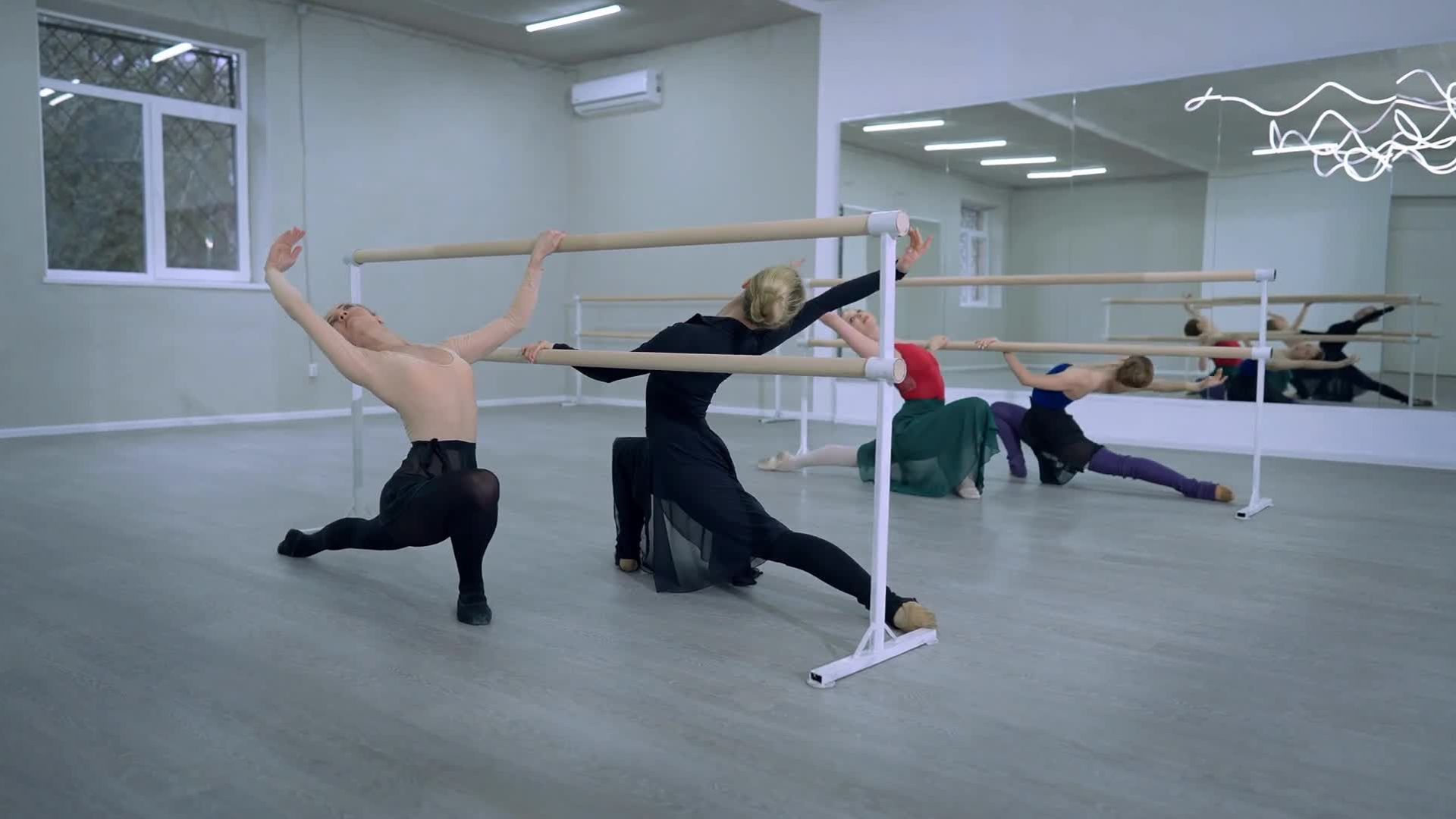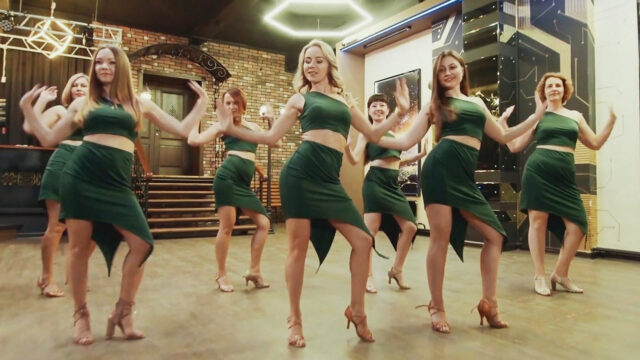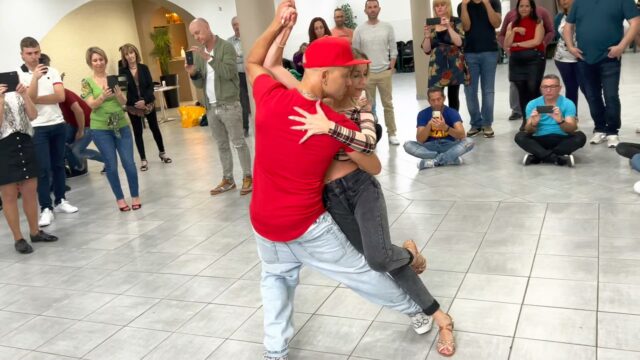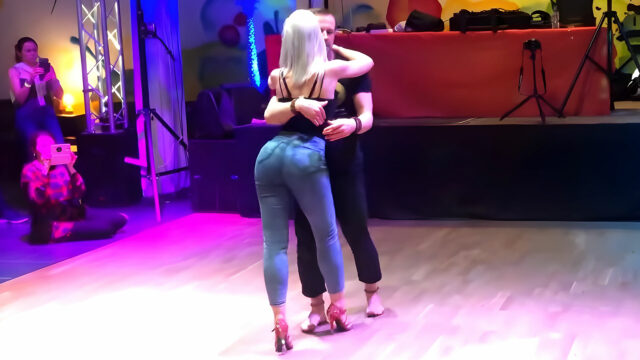The ballet barre is one of those iconic pieces of equipment that almost takes on a romantic life of its own. You will have seen it portrayed in countless beautiful and artistic ballet photographs and it really is an important part of the history and practice of ballet. In recent years, the ballet barre has also come to mean something quite different as well. With barre exercise more popular than ever, the barre itself has taken on a life of its own beyond ballet. Whether you’re a ballet dancer, have a child who’s learning ballet, or you’re dipping your toes into the barre fitness world, read on for our guide on ballet barres for your home or studio.
Quick jump to:
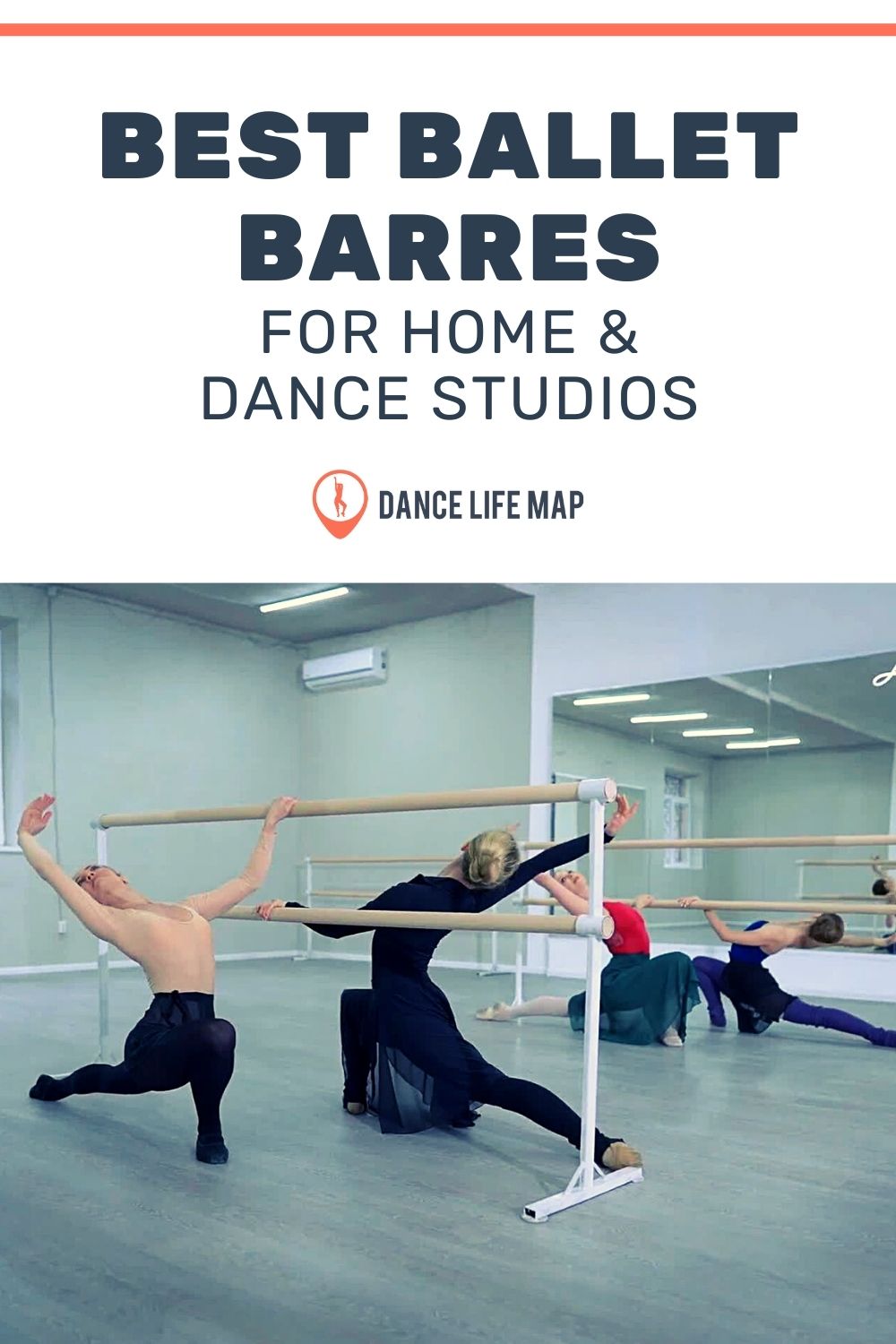
Best ballet barres for home and studio
Whether you or your child are learning ballet or barre fitness, having a barre at home can be a big asset. Lots of people make do when they are practicing ballet at home with the back of a dining chair but that doesn’t give you the same stability as a real barre and it often isn’t the correct height. Or you might be doing your barre fitness completely online, in which case investing in an at-home barre would really help you to get the full benefit of the workout.
Please note, that DanceLifeMap is reader-supported and as Amazon associates we earn from qualifying purchases. When you buy products using our links, we may earn commissions from some of the retailers while you pay the same. Now that everything is as transparent as it can be, let’s continue!
Freestanding and portable ballet barres
Freestanding ballet barres are a great option if you value portability and space-saving. Not everyone has a dedicated studio to practice in and lots of people don’t have a huge amount of space to work with or don’t want their ballet barre to be out all the time. The important thing when it comes to freestanding ballet barres is to make sure that they are able to take your weight and that they aren’t going to topple over. They don’t have the benefit of being mounted to a wall so they have to be sturdy enough to be used while standing on their own.
Marfula Adjustable Double Ballet Barre With Carry Bag
If portability is important to you, then this ballet barre will be perfect. It comes with its own carry bag which means that you can take it anywhere you need to go. So whether you’re a teacher who needs to transport their barre from lesson to lesson or a student, you won’t ever need to leave your barre behind. This also makes it really easy to store away.
It is made of heavy-duty steel and has two solid beech crossbars and is covered in a no-rust solution which means that it can even be used outdoors. The barre weighs 20lbs in total and is 4 feet wide. The top crossbar has a maximum height of four feet and can be adjusted.
This barre also comes with a stretch band and a turning board to help support your ballet practice even more.
Features at a glance:
- Height – up to 4ft
- Length – 4ft
- Double bars
- Adjustable
- Portable with own carry case
- Solid beech crossbars
- Comes with stretch band and turning board
Get Out! Ballet Barre For Home Or Studio
This ballet barre is very portable and comes with its own carry bag. This makes it a perfect option for teachers and students alike who want to be able to take their barre with them wherever they go. It weighs only 9lbs which means that it is very easy to carry.
It has two crossbars and a maximum height of 4 feet, which can be adjusted. It is 21.5 inches wide. The feet have rubber non-slip pads and it can be constructed without the need for any tools.
Features at a glance:
- Height – up to 4ft
- Weight 9lbs
- Width – 21.5 inches
- Portable with carry bag
- Adjustable
- Double bars
- No-tool assembly
Wall-mounted ballet barres
While portable freestanding ballet barres can be very useful for a whole host of reasons, a wall-mounted ballet barre has its own benefits. It is far more stable to begin with, and you never need to worry about it tipping over because it is securely attached to a wall. It also means that you can adjust the height precisely to be perfect for you. And, because there is no base, you can have complete freedom of movement when you are working parallel to the barre without needing to worry about your feet catching on the base.
The key features to look out for with wall-mounted ballet barres are how securely they attach to the wall and how strong the bar itself is. Because there is no underlying frame for the bar to rest on, if it isn’t secured properly to the wall and the bar isn’t strong enough you could have the potential for bending or wobbling. It is also important that you make sure the wall you are attaching the barre to is able to support it properly.
Vita Vibe Single Bar Traditional Wood Ballet Barre System
If you want a professional-looking ballet barre, then this wall-mounted barre system from Vita Vibe is perfect. It is USA-made and the bar is made from sanded hardwood ash, without splinters, and is 1.5 inches in diameter. The length of the barre is 6 feet, which means that more than one person can use it at the same time. The edges of the bar are rounded, which gives it that extra professional look.
The wall brackets are made from 1/4 inch powder-coated steel and, when properly mounted, the barre can take 100lbs of weight.
Features at a glance:
- Length – 6 feet
- Diameter – 1.5 inches
- Sanded natural hardwood ash
- Powder-coated 1/4 inch steel brackets
- Rounded edges
Barre Trainer Single Traditional Wood Barre
This is another great-looking barre. It is made from sanded beech wood and is 1.5 inches in diameter. It comes in three different lengths: 3 foot, 4 foot, or 5 foot, depending on your preference. It is secured to the wall using two steel brackets, and included is the hardware for mounting the brackets into studs as well as additional screws.
Features at a glance:
- Length – 3 foot, 4 foot, or 5 foot
- Diameter – 1.5 inches
- Sanded beach wood
- Two steel brackets
Fixed Height Professional Wall-Mounted Double Ballet Barre
This wall-mounted ballet barre from Pro-Gymnastics is made in the USA out of traditional wood. It is a 6 feet double barre, which makes it more versatile especially when teaching. Its brackets are 1/4″ powder coated heavy duty thick durable steel with a smooth finish which makes it really sturdy. The distance between 2 barres are around 7.5 inches.
Features at a glance:
- Length – 6 feet
- Traditional wood with heavy duty brackets
- Double bar
- Very sturdy
Ballet barre accessories
Booty Kicker Tablet Holder For Home Fitness Exercise Barre
Like many of us, you may be finding that you are doing most of your workouts online at the moment. Or maybe your child’s ballet classes are zoom-only for the time being. For most fitness classes, this isn’t too much of a problem because you can just park yourself in front of the TV or your laptop and you’re good to go. It can be an issue for barre classes, however, because it is difficult to arrange yourself in such a way that you can stand comfortably at the barre and watch the screen at the same time.
Enter the Booty Kicker Tablet Holder. This is a clever idea where your tablet or your phone are actually attached to your barre so that you can see the screen the entire time you are in class or the entire time you are watching the video.
The holder clamps onto most standard wooden ballet barres and it has an aluminum arm that rotates 360 degrees, so you can always be sure of the perfect view. The arm is 16 inches long when it is fully extended and it will fit most phones and tablets in the clamp.
Artan Balance Barre Form Detachable Protector
There’s no doubt about it that ballet barres are hard. This isn’t so much of a problem when you are completing standard barre exercises like the pile or tendu and you are only holding onto the barre with your hand. It can be more of an issue, however, when you are using the barre to help you stretch out your calves and legs. Hooking your leg onto the barre for an extended period of time can become quite uncomfortable.
Some of the barres we have covered have foam protection pads built-in, but if you are going to be using a barre that doesn’t, then this foam slider can work wonders. It is made of super-soft foam and it has a zipper to make it easy to slip on and off the barre whenever you want. So you can take this slider with you and pop it back in your back once you’re done. It is also machine wash and tumble-dry friendly.
What is a ballet barre?
A ballet barre is a horizontal bar, often made of wood or sometimes metal that is either mounted on a wall or part of a freestanding structure. It is usually set at 3.5 feet from the floor, which is approximately waist height. Some barre set-ups have two horizontal bars, with the lower one for children’s use. The ballet barre has been in use since the 19th century.
There are two purposes to the ballet barre. The first is its use as a tool during warm-up stretches, and it is used by ballet dancers from beginner to expert for this. The second is as support when practicing ballet techniques and principles, and it is mainly used by beginner and intermediate ballet dancers for this purpose.
For that latter purpose, the ballet barre acts as a form of support to help with balance so that dancers can focus on the precise muscle movements that they need to make to perfect the different positions and steps that they need. These form a foundation for further ballet progression and students will spend years practicing at the barre to make sure that they are able to execute all of their movements perfectly.
Ballet barre exercises
Ballet barre exercises are a core element of beginner and intermediate ballet classes and they will help you gain the solid foundation you need. Here are a few of the core ballet barre exercises you might learn (see here for more information).
Tendu front, side, and back
With your feet in third position and your arm out in second position, slide your foot to the front, side, or back until your pointed toe is in contact with the floor, then bring it back to third position.
Degage front, side, and back
This is the same as tendu, but this time instead of your pointed toe being in contact with the floor, you will lift it up just a few inches before bringing your foot back to third position.
Grande batterments
This uses the same foundation as tendu and degage but this time you will execute a slow kick to the front, side, or back until your leg is at hip height. Your back and hips should be perfectly straight throughout.
Demi plie in first
With your feet in first position and your arm in second position, bend your knees out to the side while keeping your back perfectly straight.
Full plie in first
This is the same as the demi plie, but this time, you will continue to bend your knees until your heels are lifted off the floor while bringing your arm into first position.
Demi and full plie in second
These plies are the same the demi and full plie in first, but this time your feet will be in second position throughout.
What is barre fitness?
Barre fitness has become very popular in recent years. One form of barre fitness or another seems to be popping up everywhere, so you would be forgiven for thinking that it was a recent invention. But this isn’t actually the case. Barre fitness was first developed in the 1950s under the guidance of Lotte Berk. She was an influential ballet dancer who fled the Nazis in the 1930s and realized the potential of barre work as a form of fitness that would appeal to the masses.
The Lotte Berk method focused on isolation exercises, much like modern barre fitness does. The aim of the Lotte Berk method was to give women the body and the posture of a ballet dancer with carefully designed barre exercises, strength training, and some hatha yoga. And all with a touch of glamour over the top. The Lotte Berk method spread and grew in popularity but, over time, it started to receive some criticism.
The isolation exercises that were implemented could be hard on people’s joints and there were reports of injuries from devout attendees and classes were very expensive. So people started to modify the method and come up with their own versions and from there, the barre fitness world started to grow.
Barre fitness is very different from ballet dancing. There is no dancing involved with barre fitness, and really no cardio. So it’s nothing like attending an adult ballet class or something similar. If you do attend an adult ballet class, you will of course do some barre work as part of your training, but you will also be dancing and learning choreography at the same time.
Instead, barre fitness utilizes the sorts of barre exercises that we looked at in the previous section. Each of these exercises will isolate particular muscles. Often, in barre fitness, rather than completing the entire movement, you will “pulse” and use an extended hold to fully isolate the muscles that you are using.
Isolation exercises are useful in two different ways. First, they help to isolate particular muscle groups to give you extra definition and/or strength. This can often be difficult to achieve using compound movements only. Second, they can be very useful when rehabilitating from an injury. And, in fact, Lotte Berk herself used her experience with rehabilitating from a back injury to inform her Lotte Berk barre method.
Barre fitness has a range of health benefits. It can help to build muscle, improve your posture, and improve your cardiovascular health. It can also help to increase your bone density, which can help to stave off osteoporosis.
Barre fitness is also often mixed with yoga and Pilates, and you will often find the classes operating in the same studios. Yoga and Pilates have been exercise programs that ballet dancers have been using for a long time alongside their ballet training because they train the muscles in a similar way and promote flexibiltiy, so it makes sense that barre fitness would find a home alongside these disciplines. And for yoga and Pilates elements to become intermixed with barre fitness.
Pilates uses the same principles of muscles isolation and comes from a similar rehabilitation background. Yoga is quite different and has more of a focus on flexibility. Together, these two disciplines plus barre can really help you to achieve the body goals that you are looking for, as well as improve your strength, posture, and flexibility.
The bottom line
A barre is an important part of any ballet dancer’s life. As is practicing, practicing, practicing. While you can make do with household equipment to practice at home, investing in a proper barre can do wonders for your technique. Some barres are portable and freestanding, and these are perfect for smaller homes, or for ballet teachers whose classes move from place to place. Other barres are wall-mounted, and these are great for anyone who has a dedicated studio area. A lot of barres can be height-adjusted so that they will be perfect for you or your child as they grow. Whatever type of barre you need, and whether you need it for ballet practice or barre fitness, there is one out there for you.
